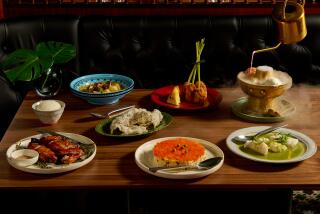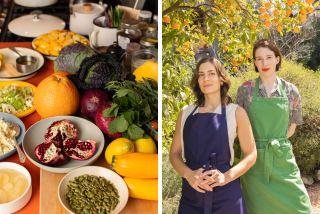Bay leaf stirs the senses
SO MANY things in recipes are optional. But if you live in Southern California, and you lack that bay leaf for a soup, stew or roast, it’s almost criminal to cook without it.
This is the one place in North America with a Mediterranean climate. As such, we have fresh bay leaves attached to actual bay trees, which grow so well that you even see them used as hedges.
The sight of a bay tree is the cue to pluck a few leaves and head on to the nearest farmers market. Whatever you buy there will taste better because of the leaves in your pocket.
For dishes that are boiled or braised, the astringency imparted by the bay leaf becomes the spine of the flavor structure. For roasts, you can use many more leaves, and in this case, it’s the aromatics that come into play.
But before you go a-plucking, then a-cooking, make sure that you have the right sort of tree. We’re so spoiled for fresh bay trees here that we have two common types, one native, one an import from the Mediterranean.
The native one, Umbellularia californica, is the rarer. In the wild, our native bay trees tend to occur in woodsy arteries along canyons and foothills to about 5,000 feet, where they enjoy the company of conifers and oaks. When they’re found in developed areas, they’re generally huge, broad-canopied specimen trees -- holdovers from pioneer days, when they were often planted with eucalyptus, for which their elliptical, light green leaves might well have been mistaken. Their bark is brown, the flowers that appear from winter solstice through spring are yellow, but the best way to identify them is the scent.
As morning fog dissipates and sun finally cooks the dew off their leaves, a bewitching aroma almost like good after-shave rises, then mingles confusingly with the smell of the car exhaust and citrus blossom that constitutes the greater atmosphere of Los Angeles.
--
Go for Mediterranean
Their leaves can be used for cooking and are found in tribal recipes and herbals, and even used in a crossover capacity in European dishes. Yet in flavor, aroma and even in behavior in the cook pot, California bay is more like a native sage, to my taste better suited for the perfume counter than the kitchen. So the remainder of this article is strictly about the much more commonly planted Mediterranean bay.
This is the international culinary standard for bay, the bay laurel tree, also called sweet bay, Turkish bay, or to the botanically correct, Laurus nobilis.
For the historically minded, the most fascinating things about the bay laurel tree are its roots in Greek mythology and romance languages from Apollo onward. Southern Californian garden designers like how well these sturdy green trees tolerate wanton irrigation and take hard pruning into thick, tall privacy hedges. Here and now, however, it makes sense to cut straight to the stem, where you’ll be plucking one leaf for stews and as many as two dozen for a roasting tray full of potatoes and onions.
Like the California bay, the leaves of Laurus nobilis have essential oils that give them pungency and aroma. But these elliptical, olive-green leaves are far more reluctant to give up their goods.
The leaves are so tough that when you see a bay sapling in a nursery, its tag will probably carry the sales pitch “deer resistant.” It would be a hungry ruminant that would happily browse on leaves with so much cellulose, or, as my friend, plant chemist John Fellman, puts it, “dry weight per unit surface.”
The leaves are so rugged that during drought, they stubbornly brown at the tips instead of wilting. Even after cooking, the leaves refuse to disintegrate, a quality that gives them a reputation as a choking hazard and inspired the 1993 New Yorker cartoon “Bay-leaf Watch.” In this, a lifeguard stationed in a fancy dining room shouts through a megaphone, “You, in the dark-green three-piece suit, eating the bouillabaisse! You’ve got one on your spoon! Repeat -- you’ve got one on your spoon!”
--
Releasing the magic
As BAY laurel leaves cook, the shape holds, but the volatile chemicals are released. These, says Fellman, also evolved to deter predators. But what deer don’t like, we do -- in moderation.
Four years ago, Turkish researchers from Zonguldak Karaelmas University took the time to tweak apart these chemicals and classify their aromas. They found odors redolent of sweet apple, eucalyptus, flowers, olive oil, cloves, pepper and, less appetizingly, of wet paper and plastic.
Though the highest concentration of oils was found in young leaves in July, pluckers please note: The best flavor was detected in October.
The art in cooking with the leaves is to capture the flavors you want and escape the ones you don’t. San Francisco chef Judy Rodgers recalls as a young cook thinking, “If one bay leaf is good, more are better.” She doesn’t remember how many she put in a duck braise, just that “When I pulled that puppy out of the oven at quarter to 6, it was terrible. You could not eat it. It was like biting into an Excedrin.”
So for a bouquet garni for a braise or stew, as a rule, Rodgers warns, one bay leaf will do.
But rules change for roasting. Mozza chef Nancy Silverton has been known to hand friends a basket and send them down the road from her house with instructions to pick a dozen or more. Then Silverton likes to stud a roasting pan filled with potatoes, sweet onions, fennel or combinations of the three, with 10 or even 20 bay leaves.
Silverton would never do this in a stew, but in the roasting pan, she’s capturing the aromatics so closely guarded by those tough leaves without unleashing too much astringency.
The roasted leaves look so beautiful in the finished dish that, bay-leaf lifeguards aside, it’s impossible not to eat one.
It disintegrates like paper on the tongue.
It’s good!
That begs a second.
By the third, your tongue will be going a bit numb and you appreciate why deer steer clear of bay leaves. Instinct will tell you to stick to the potatoes, whose caramelized edges, roasting juices and rising steam will be impregnated by the arresting aromatics of summer, captured and released by bay leaves.
--
--
(BEGIN TEXT OF INFOBOX)
Growing your own bay leaves
Where to buy: Bay laurel (Laurus nobilis) trees can be found at Armstrong Garden Centers (check armstrong garden.com for locations), Marina del Rey Garden Center and other area nurseries.
Price: Costs vary from $30 to $50 for a 5-gallon pot.
Where to plant: They can be maintained in pots for patio and balcony gardens given good drainage and regular water, or planted out in most California gardens where they will need weekly to monthly irrigation as they become established. They take hard pruning, can be used in close-planted hedges and as topiary, or they can become large stand-alone trees.
Caution: Contaminated nursery stock was identified as one vector of Phytophthora ramorum, the pathogen responsible for California and Oregon epidemics of sudden oak death, so gardeners beware: Buy bay laurel trees only from a reputable grower, never buy a runty specimen, and think twice before putting them near oaks or oak woodlands. The major regional supplier, Monrovia Growers, confirms that it has never had such a case in Laurus nobilis and that it checks assiduously to keep the stock healthy.
-- Emily Green
--
Roast potatoes, onions, fennel and bay leaves
Total time:
1 1/2 hours
Servings:
4 to 6
Note:
From Nancy Silverton. This is a summer dish that captures the run of new potatoes, fennel and sweet onions in farmers markets. The charred and roasted bay leaves can be eaten and have a fantastic woodsy flavor, but leave it to one or two or the astringency will strip your tongue.
6 tablespoons good-quality olive oil, divided
2 teaspoons coarse sea salt, divided
1/2 teaspoon freshly ground black pepper, divided
2 pounds new potatoes (about 12), cleaned
12 bay leaves, or one for every potato
1 1/2 pounds small sweet onions (about 6), peeled and trimmed
1 large head fennel, trimmed (reserve 2 sprigs from the top)
1. Heat the oven to 500 degrees. Lightly oil a 9-by-12-inch baking dish. Pour 3 tablespoons of the olive oil into one corner of the dish. Season this puddle with 1 teaspoon salt and one-fourth teaspoon pepper (you’ll use it to dip the potatoes).
2. Halve the potatoes. Dip each half into the seasoned olive oil, then put the halves back together with one bay leaf sandwiched between, leaving the prepared potatoes in the dish.
3. Cut the onions into 8 lengthwise wedges. Separate the layers of the fennel bulb and cut the pieces into 1-inch strips.
4. Arrange the vegetables in the dish, alternating seasoned potatoes with onion and fennel pieces. Drizzle with the remaining olive oil. Season with 1 teaspoon salt and one-fourth teaspoon pepper. Top with the sprigs of fennel, and cover lightly with foil.
5. Place the dish on the middle rack of the hot oven and reduce the heat to 450 degrees. Cook for 30 to 45 minutes, until the potatoes are almost tender. Remove the foil and continue to roast an additional 15 minutes.
6. Remove the dish from the oven and turn the potatoes, onions and fennel so the other sides caramelize. Return to the oven and roast another 10 to 15 minutes, until the bay leaves are charred and brittle, the onions brown and molten, and the fennel pieces papery and crunchy or molten. Serve immediately.
Each serving: 294 calories; 5 grams protein; 40 grams carbohydrates; 6 grams fiber; 14 grams fat; 2 grams saturated fat; 0 cholesterol; 811 mg. sodium.
--
Kebabs with bay leaves
Total time: 30 minutes
Servings: 4
Note: Increase or decrease the meat as you have it or want it, or forgo it for vegetarians. You can also double or triple the tomato content. You will need 4 large skewers. Bring the meat to room temperature before cooking.
1 pound lamb or beef cut into 1-inch cubes
20 small bay leaves, or 1 for each cube of meat
1 large bell pepper, trimmed, seeded and cut into roughly 1-inch pieces
8 cherry tomatoes
2 medium onions, trimmed, peeled and cut into 8 lengthwise wedges
Good quality olive oil
Coarse sea salt
Freshly ground black pepper
1 lemon, cut into wedges
1. If using disposable wooden skewers, soak the skewers in water for about 10 minutes before using.
2. To prepare the skewers, alternate paired meat cubes and bay leaves with the pieces of pepper, tomatoes and onion wedges. (You can put a couple of sacrificial lamb chunks at one of the ends so the cook can easily taste-test for doneness.) Lightly brush the prepared skewers with olive oil, and season each large skewer with one-half teaspoon salt and a pinch of pepper.
3. Grill each skewer over a medium-hot grill or broil for 5 minutes, then turn over and cook the other side an additional 5 minutes, or to desired doneness. Remove and allow the meat to rest for a few minutes. Serve with more sea salt, pepper and generous wedges of fresh lemon.
Each serving: 255 calories; 22 grams protein; 10 grams carbohydrates; 2 grams fiber; 14 grams fat; 4 grams saturated fat; 67 mg. cholesterol; 1,217 mg. sodium.
--
Deborah Madison’s lentil salad
Total time: 40 minutes
Servings: 6
Note: From “The Greens Cookbook.” Puy lentils are at Whole Foods markets, Nicole’s Gourmet Foods in South Pasadena and Monsieur Marcel at the Fairfax Farmer’s Market. Brown lentils are at Trader Joe’s. Make a day ahead; the flavors improve overnight.
Lemon vinaigrette
3 tablespoons lemon juice, or more to taste
1/2 teaspoon finely grated lemon zest
1/2 teaspoon paprika
Pinch cayenne pepper
1 clove garlic, minced
1/4 teaspoon sea salt
6 tablespoons olive oil , or more to taste
1. In a small bowl, combine the lemon juice and zest, the paprika, cayenne, garlic and salt. Whisk in the olive oil. The dressing should be tart. Taste and adjust seasoning, oil and lemon juice.
Assembly
1 1/2 cups small French lentils (Puy or brown), rinsed
1 medium carrot, peeled and diced into 1/8 inch cubes
1/2 small onion, finely diced
1 bay leaf
1 clove garlic, finely chopped
1/2 teaspoon salt
2 medium red bell peppers
2 teaspoons chopped mint
1 tablespoon chopped parsley
1 tablespoon chopped marjoram
1 tablespoon chopped thyme
8 ounces feta cheese, divided
Freshly ground pepper
Red wine vinegar
Good quality olive oil
1. In a medium saucepan combine the lentils, carrot, onion, bay leaf, garlic and salt. Add enough water to cover and simmer until tender, 20 to 25 minutes.
2. While the lentils are cooking, roast the peppers until charred on all sides. Cool and peel the charred skins. Core, seed and dice the peppers into quarter-inch squares.
3. Drain the lentils into a bowl, reserving the liquid if you wish.
4. Fold the vinaigrette into the warm lentils, followed by most of the red peppers, the parsley, marjoram and thyme. Crumble half the feta and stir it into the salad.
5. Taste and adjust the seasoning, adding pepper and red wine vinegar to taste. Garnish with the remaining red pepper, crumbled feta and a drizzle of olive oil.
Each serving: 402 calories; 19 grams protein; 35 grams carbohydrates; 12 grams fiber; 22 grams fat; 8 grams saturated fat; 34 mg. cholesterol; 724 mg. sodium.
--
Online recipe
Bay leaf bonus: White beans (for salads and soups) at latimes.com/food.
More to Read
Eat your way across L.A.
Get our weekly Tasting Notes newsletter for reviews, news and more.
You may occasionally receive promotional content from the Los Angeles Times.










